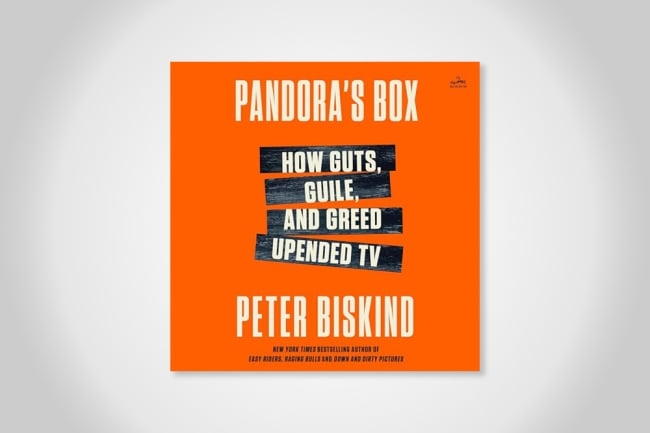You have /5 articles left.
Sign up for a free account or log in.

HarperCollins
Pandora’s Box: How Guts, Guile, and Greed Upended TV
by Peter Biskind
Published in November, 2023.
What was the last movie you saw in a theater?
How many streaming services do you subscribe to?
And might your answer to these questions tell us anything about the future of higher education?
Pandora’s Box traces the history of the transition from movies (shown in movie theaters) to TV (viewed at home) as the center of prestige culture. If there is a date when TV became more influential than cinema (at least within the chattering class), it was January 10th, 1999—the day The Sopranos debuted on HBO.
The wave of entertainment created for release on screens other than those in movie theaters crested in 2022 when 600 scripted shows could be viewed across cable and streaming platforms. Pandora’s Box goes behind the scenes of many of the most influential, entertaining and sometimes lucrative examples of these shows.
Fans of The Sopranos, Mad Men, Deadwood, Breaking Bad, The Shield, The Wire, Justified, The Americans, and Game of Thrones will enjoy these groundbreaking series' creative and corporate origin stories.
Where I started to see higher ed connections between the rise of in-home prestige TV and the fall of the in-theater film is when Pandora’s Box shifted its attention to streaming. As a thought exercise, suppose we allow ourselves to make the following (imperfect) equivalencies:
Entertainment Companies = Universities
Movie Theaters = Residential Classrooms
Cable TV = Online Degrees
Streaming Companies = Scaled Online Learning Platforms
Yes. I know. These are all false equivalencies. The higher education industry is different from the movie and TV business. We live in separate worlds. But, to stretch our thinking, let’s go with it.
One of Pandora’s Box’s lessons is the impact on quality resulting from the rise of streaming. Where HBO, Showtime, and later AMC and FX enabled a fundamental improvement in the quality of scripted shows compared to what was on offer on network TV, the transition to streaming has been a mixed-quality story.
Paid cable TV drove better television because of the difference in business models. HBO (when it was cable-only) made its money through subscriptions, not advertising. The network did not have to create shows for a mass audience and did not have to navigate FCC content rules. The best shows on cable, such as The Wire and The Americans, were more like visual novels or long-form films than network TV shows. The best cable TV shows were writer-driven rather than star-driven.
We can make a similar, if slightly altered, argument about the impact of online degrees on educational quality. The least-told story of the rise of online learning is how these new programs could smuggle learning science (and learning designers) into traditional universities.
The most impactful faculty professional development activities over the past 25 years have not been workshops but faculty collaboration with a learning designer in the development of an online course.
What has the rise of streaming meant for quality shows and movies? At first, as described in Pandora’s Box, the story was hopeful. When the entire first season of House of Cards debuted on Netflix in 2013, there was genuine excitement that streaming might enable new creative opportunities.
However, the possibility that streaming services will bring about a quality renaissance has largely evaporated. Today, wealthy tech companies run streaming services that launch mostly forgettable shows. Audiences are algorithmically segregated, with shows green-lit based on their potential for viewer engagement rather than for originality.
In online education, the future is all about scale. Scale in the form of mega online universities, such as Arizona State University (ASU), Southern New Hampshire University (SNHU) and Western Governors University (WGU). And scale from online learning platforms, such as Coursera and edX. Corporate integration into online learning is everywhere. (Hello, Google Professional Certificates and the ASU+GSV Summit).
In media, the business imperatives of streaming now shape much of what gets created. How much of the design and operations of our universities are determined by the affordances and constraints of scaled online programs?
What are you reading?




